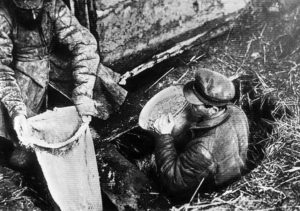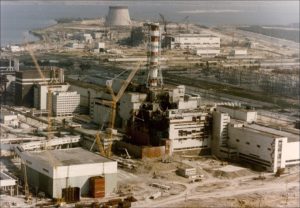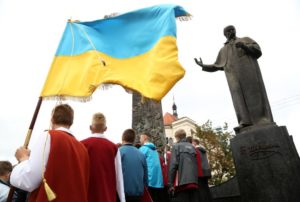A History of Ukraine: Battleground for Empires – Part 2
Ukraine finally gains independence – but could that really be the end of the story?
By: GenZ Staff | March 10, 2022 | 891 Words

(Gabrielle Lurie/San Francisco Chronicle via Getty Images)
This is Part Two of “A History of Ukraine: Battleground for Empires.” In Part One, we looked at Kiev’s golden age, the fall to empires, and the first try for independence. You can read it here.
Now, we continue the story with Ukraine joining the communist Soviet Union…
The Ukrainian Soviet Socialist Republic
Under the Soviet Union, Ukraine existed as the Ukrainian Socialist Soviet Republic.
 The Soviet Union had taken over a lot of land in Europe and Asia, so it now had 14 republics, as well as Russia. How was it going to manage all these different peoples?
The Soviet Union had taken over a lot of land in Europe and Asia, so it now had 14 republics, as well as Russia. How was it going to manage all these different peoples?
During the old days of Imperial Russia, there was a policy of “Russification.” This means Russia tried push its own culture in conquered lands, banning native ones. Now, the Soviets tried the opposite method. In the early years, it had a policy of “Korenizatsiya,” which promoted the native cultures of each republic under its control. In Ukraine, this was called “Ukrainization.” The Ukrainian language and culture were promoted. But this didn’t last. By 1940, Ukrainization was out, and Russification was back in.

Soviet officials confiscate grain from a peasant household in Ukraine, 1932-1933. (Photo by: Pictures From History/Universal Images Group via Getty Images)
Aside from the conflict over the native culture, there was also great hardship. The Soviet Union’s communist policies didn’t let individual people own land, so farms were taken over and run by the government, or by communes. The communists thought this would increase the amount of food grown, but it had the opposite effect.
Ukraine suffered a terrible famine, called the Holodomor. Anyone who opposed the Soviet policies was also killed or arrested. It’s thought the Holodomor killed between around three million and ten million people. Today, there is still disagreement on whether it was a planned genocide of the Ukrainian people or just the grave result of bad ideas. Many Russians and other Soviet peoples also starved and suffered under communism.
World War II arrived. While most Ukrainian soldiers fought with the Soviet Red Army, nationalist groups began again to spring up in the west, such as the Ukrainian Insurgent Army. In 1941, Nazi Germany held a surprise invasion and took over part of Ukraine, called the “Reichskommissariat Ukraine,” but two years later the Germans had to retreat from Soviet attack.

View of the Chernobyl Nuclear power plant three days after the explosion on April 29, 1986. (Photo by SHONE/GAMMA/Gamma-Rapho via Getty Images)
After World War II, the Soviet Union became more powerful, growing into one of the world’s two superpowers. It competed against the United States for power on the world stage. Life in the Soviet Union continued to be harsh, though, and Ukraine suffered from famines, poverty, and totalitarian rule.
Ukraine grew as a center of industry, making a lot of items in factories. The Chernobyl nuclear power plant was built on the republic’s northern border in the 1970s, but in 1986 it exploded. This is still considered one of the worst nuclear accidents in history. The radiation caused hundreds of deaths. An area of 30 kilometers (18 miles) was evacuated, including over 100,000 people. Today, the health effects of the accident are not fully known, and the Chernobyl area is still radioactive.
Eventually, Soviet power began to wane. Ukrainian nationalism slowly grew. “Ukrainization” was back. In 1989, a new constitution was approved, making Ukrainian the only official language in the republic.
Finally, on December 25, 1991, the Soviet Union collapsed. Just a few weeks before that, on December 1, the Ukrainian people had voted to become an independent nation.
Independent Ukraine

Ukraine celebrates thirty years of independence in 2021. (Photo by Adam Berry/Getty Images)
Finally, Ukraine was recognized as an independent nation. The native culture and language were promoted, and in 1996 a new constitution was adopted. The media became more open, and new ideas were allowed to flourish. There were problems, though. The country was still poor, and crime increased. In 2004, Ukraine almost collapsed; the government was accused of corruption and the people took to the streets, protesting in what is now called the Orange Revolution.
Ukraine distanced itself from Russia and adopted a more Western, or European, identity. Tensions began to arise. Not everyone wanted to be a part of the Western-style Ukraine. Some groups wanted to keep close ties with Russia. Since then, Ukraine has been pulled in two directions – should it join the rest of Europe, or stay allied with Russia? Different regions have different opinions, and it has caused warfare in the country.
Conflict erupted in 2014 between pro-European western Ukraine and pro-Russian eastern Ukraine. The eastern “Donbas” region of the country rebelled, with help from Russia.
Russia’s top officials still think Ukraine should belong to their country, and it launched an invasion in 2022. However, Ukraine has fought fiercely to keep its independence.
Russia, Poland, Mongolia, Cossacks, Austria-Hungary – these entities, and more, have all had a hand in shaping the lands of Ukraine. With a long history of division and control by diverse empires, it’s no surprise that different areas of Ukraine have grown with different identities. Can these conflicts be resolved, or will the country be pulled apart?
















